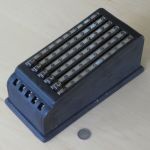
The Add-O-Matic Adding Machine
Video
History
Advertisements
Links
The Add-O-Matic Adding Machine is a simple and cheap adding machine. Like the Add-em and the Peter Pan adding machine it is made from thin metal plate that is put together with tabs in slots, but this one is a bit classier. It had rubber feet (they are missing on mine, probably because the rubber degraded over time) and has a typical art-deco abstract wing design in the sides of the case.
There is a 5-digit register at the front, and along the top are 5 long slots, marked with the digits 0 to 9 along the side, and each with a bakelite slider. To enter a digit, move the slider up to the required digit, then push down on the brass knob on the slider and while doing so slide it back down to zero.
There is no clearing mechanism. To clear the register you have to do so manually by adding the complementary digits from right to left. Subtraction is done using complementary digits.
It is a chain adder. Each chain has 30 plate-like links, with each plate bearing one digit. The chains are looped around a wheel at the front, where the register window is, and a wheel at the back, which is where the carry mechanism is located. The rear wheels are exactly ten links in circumference, and have a leaf spring attached to the left hand side. When the spring reaches a gap in the dividing wall between the wheels, it pokes through and engages with some teeth on the side of the next wheel.
Here is a video where I demonstrate the Add-O-Matic.
This video shows the mechanism of the Add-O-Matic.
The Add-O-Matic was first made in 1937 by the Allied Manufacturing Co., but after a few years it was made by James Metal Products Co., both based in Chicago. In some ads it was sold by the Add-O-Matic Co. It is not clear what the relationship was between those companies. It seems that its price dropped from about $6 or $10 in 1938 down to $4 in 1940, and by then it was sold more as a toy. Production seems to have stopped before the end of the war. Although the packaging said that patents are pending, I have not found any patents for this machine so I do not know who designed it.
Note that there were several other products with the same or similar name. In the late 1940s there was a small co-axial adder by Chadwick and also a coin bank, and later the pencil-box version of the Sterling Dial-a-matic was sometimes given the name. In the 1960s there was also the Add-A-Matic, a plastic pocket adder for shoppers similar to the Pocket Counter.
I found a few adverts for the Add-O-Matic in newspapers and magazines.
© Copyright 2020 Jaap Scherphuis, mechcalc a t jaapsch d o t net.